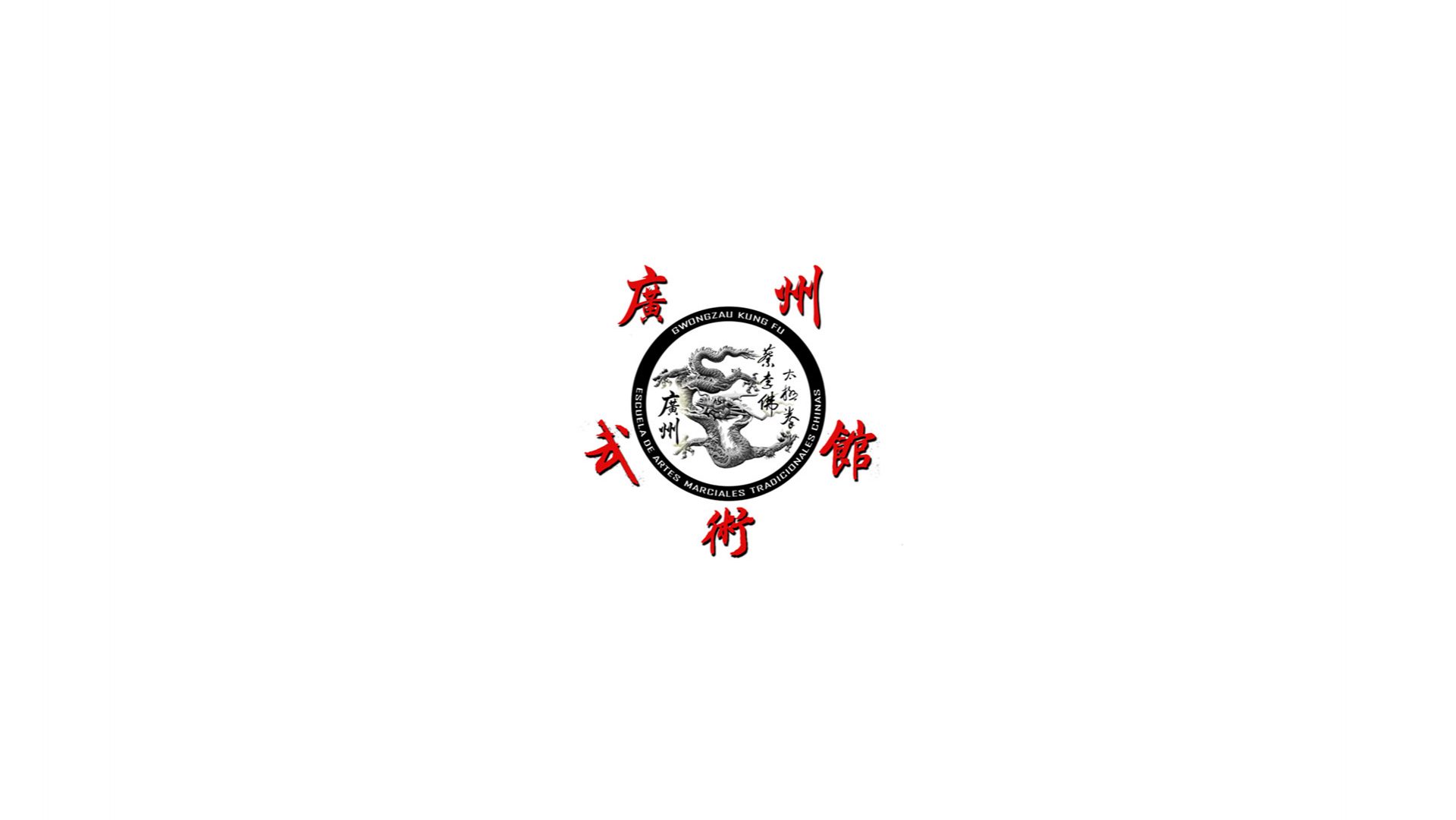Introduction
Choy Li Fut 蔡李佛 is a martial art originating in the province of Guǎngdōng 廣東 in southern China, whose legendary origins can be traced back to the Shàolín temple 少林.
Powerful, dynamic and devastating, it is one of the most important combat systems in the region and, today, it is practiced by a large number of people in many countries around the world.
We have already talked in detail on other occasions about different aspects of this Kungfu system. In this article we want to give a complete idea of the system. When necessary, we will point the reader to other articles in which we can delve deeper into certain aspects.
History of Choy Li Fut
Choy Li Fut was founded in 1836 by Chan Heung 陳享, a martial artist native to the village of King Mui 京梅, in the Jiāngmén江門 region of Guǎngdōng.
Chan Heung studied different Kungfu systems from three masters: his uncle Chan Yuen-Wu 陳遠護, the famous master Li Yau-San 李友山, and the legendary monk Choy Fuk 蔡褔.
Chan Heung named his system Choy Li Fut to honour his teachers and the Buddhist origins of the system (Choy 蔡 for Choy Fuk, Li 李 for Li Yau San; Fut 佛, which means 'Buddha').
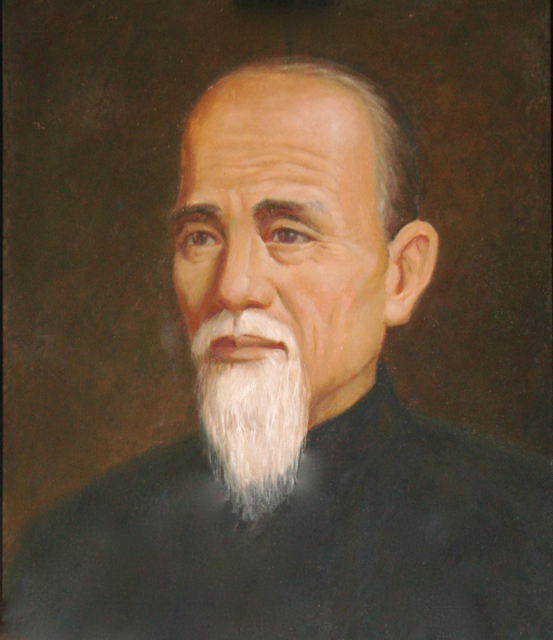
Chan Heung 陳享, the founding master.
Choy Li Fut was from the beginning linked to the training of rural militias that defended the villages from bandits, and it is quite possible that it was used in combat in some altercations of the Opium Wars, as well as in the Red Turban Rebellion (Guǎngdōng hóng bīng qǐyì 廣東洪兵起義) in the defense of Guǎngzhōu 廣州 against troops led by the secret society Tiāndìhuì 天地會.
Quickly, the fame of the system spread throughout the province and to other nearby regions. Chan Heung's students were the first martial artists to open commercial schools in the province, meaning that they taught publicly and the students paid a fee.
A short time later, their dispersion resulted in the emergence of three different styles of Choy Li Fut (see below).
The system enjoyed great popularity in Guǎngdōng until the Chinese Communist Party seized power in 1949, at which time its popularity declined in China. Up until that time, other famous southern styles, such as Hung Kyun 洪拳 and Wing Chun 詠春, developed behind Choy Li Fut.
To this day, Choy Li Fut is one of the most well-known and practiced styles of Kungfu around the world.
For an extensive and in-depth account of the history of Choy Li Fut, we refer to our series of articles "Choy Li Fut History".
Styles of Choy Li Fut
There are three styles of Choy Li Fut. Although in China they are considered to be different systems, in some schools in the West they are practiced mixed.
1. Hung Sing Choy Li Fut 雄勝蔡李佛: The original style founded by Chan Heung in 1836. It is also known as San Woi 新會 (Xīnhuì) Choy Li Fut or as King Mui Choy Li Fut. Some lineages refer to it as "Chan family."
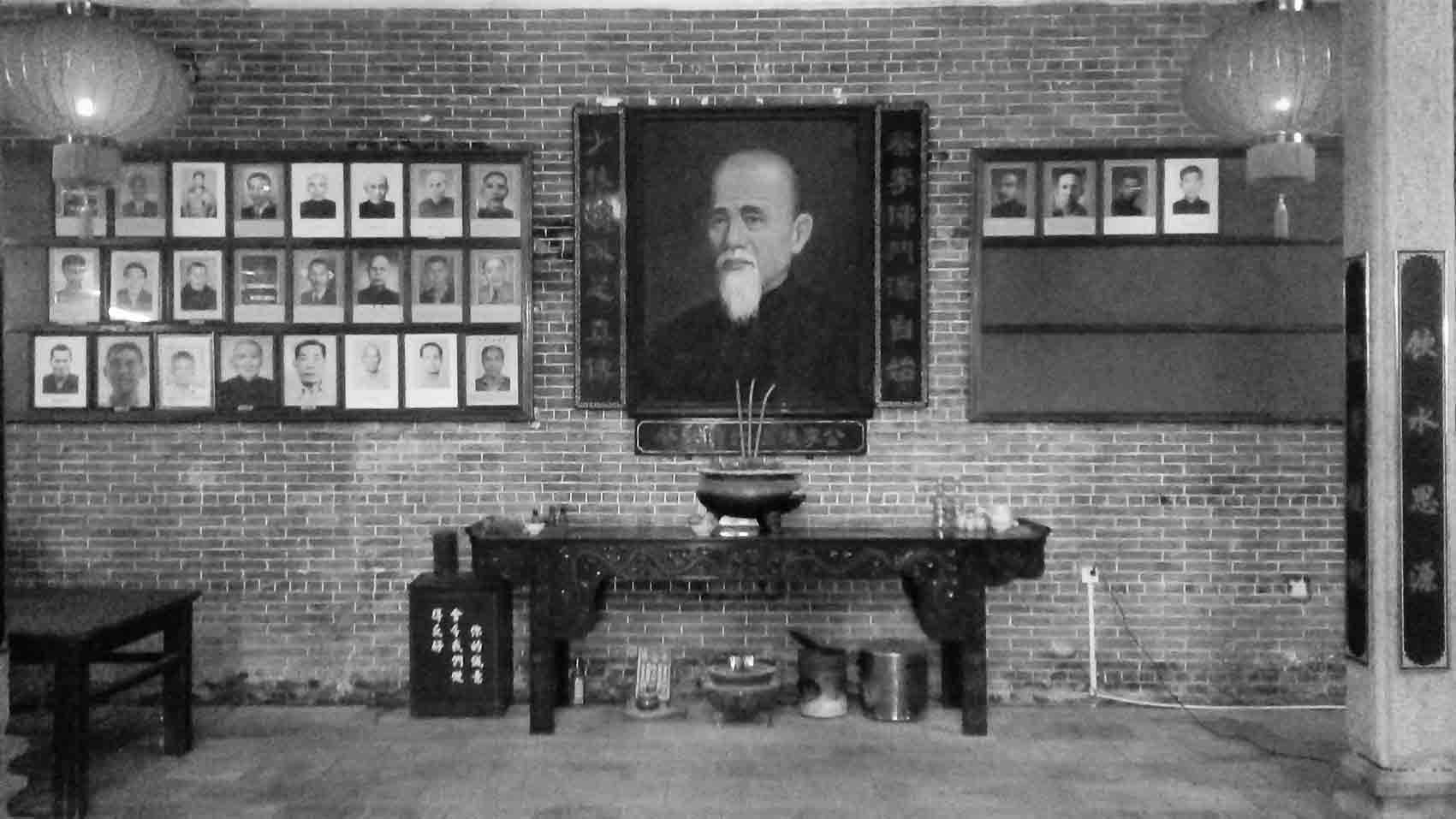
Ancestral hall of King Mui 京梅, the first place where Choy Li Fut 蔡李佛 was taught.
2. Hung Sing Choy Li Fut 鴻勝蔡李佛: Yes, it apparently has the same name as the previous one, because the characters with which their names are written in Chinese are homophones in Cantonese, but the first of the characters of each one is different.
This style was founded by Cheong Jim 張炎 (also called Cheong Hung Sing 張鴻勝), a student of Chan Heung who took over the school established in Fóshān 佛山.
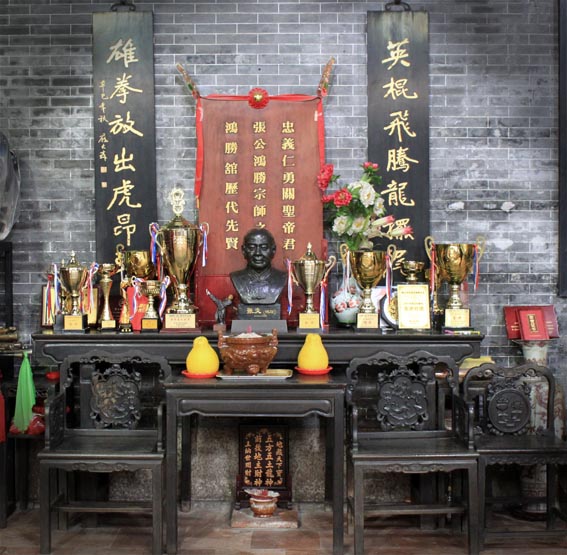
Image of Cheong Jim 張炎 in the Hung Sing Kwoon 鴻勝館 in Fóshān 佛山.
3. Bak Sing Choy Li Fut 北勝蔡李佛: Founded by Tam Sam 譚三, a wayward student at the Hung Sing 鴻勝館 school in Fóshān, who combined his knowledge with that acquired from his friend Ku Yu Cheong 顧汝章, a Shàolín practitioner established in Guǎngzhōu.
This style is known for having fewer forms and focusing more on combat exercises and applications.
Characteristics
The most important features of the system are:
1) Power from the feet and waist. In Choy Li Fut Kungfu, great power is generated by the rotation of the waist and shoulders. The concept of ma-jiu-bok 馬腰膊 (horse-waist-shoulders, where 'horse' refers to the stance) is key. This expression denotes that the generation of power in the Choy Li Fut style is born from the synchronized action of these three elements, starting at the feet, transmitting the force through the pelvic girdle and shoulder girdle, and ending in the arms.
2) From the wide to the short. Wide and fast movements, which seek to generate a large amount of power with hip twists and wide arches, are one of the most distinctive features of the system.
However, these movements generate not a little confusion, both in laymen and in practitioners of the style, because they are not correctly understood. These moves are very powerful, but in return they are easily visible to the opponent. Therefore, although they are widely used in Choy Li Fut training, they are not intended to be applied exactly, but, once the apprentice has internalized their mechanics, he or she must begin to reduce the amplitude and range, being able to generate power with less movement and over shorter distances.
3) Hands alternate in defense and attack. Both hands are used simultaneously: when one defends, the other attacks, and vice versa. Not only that, but also the same defense techniques must serve as attacks at the same time, and the attack techniques have the ability to neutralize the opponent's defenses.
Although this concept is very simple to understand, it takes a great deal of training over time to be able to carry it out accurately and effectively.
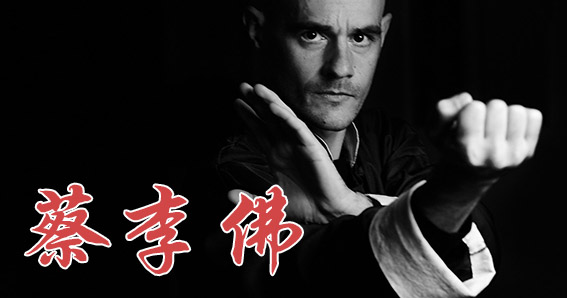
4) Low positions and solidity in movements. As a good Southern Kungfu style, Choy Li Fut maintains low stances and feet well grounded, favouring stability and a good base from which to generate power in the movement. Again, low positions are a training method, which must be correctly understood, and are not necessarily applied in a "literal" way.
5) From hard to soft. Although, at a basic level, Choy Li Fut places quite a bit of emphasis on developing skills considered 'hard' (power, speed, etc.), at an advanced level it also makes use of 'soft' skills, which seek to defeat the opponent effortlessly, leveraging their own strength against him.
All martial arts make use of these sets of skills, but some place more emphasis on one set over the other or sequence their acquisition differently.
6) Make use of contact with the opponent. Like any good Kungfu style, Choy Li Fut seeks to use contact with the opponent as an opportunity to destabilize or destructure him, immediately using this advantage to deliver the final blow.
Choy Li Fut Kungfu as a Martial Arts System:
As a system, Choy Li Fut is made up of a series of techniques, exercises, and forms.
Techniques:
In the technical field, Choy Li Fut is a style that undoubtedly favours striking over other aspects, having a great profusion of techniques, of both fists and palms, as well as legs.
Fist and palm techniques contain straight and oblique strikes, in addition to the aforementioned circular or arc strikes for which the system is famous.
It is also important to acquire some knowledge of the art of dim mak 點脈, or striking pressure points. It is not a question here of acquiring mystical or esoteric knowledge, but of knowing how to use each type of technique to direct it to the specific place where it achieves its maximum efficiency.
On the other hand, leg techniques not only include kicks, but also steps, which are also used in combat to destructure the opponent. Among the kicks, there are high and low kicks, the latter being the preferred in combat. As we usually say in our school: if you have to kick the head, make the opponent lower it first.
The technical range also includes the Five Animals (ng jing 五形) typical of Shàolín: tiger (fu jing 虎形), leopard (pau jing 豹形), snake (se jing 蛇形), crane (hok jing 鶴形) and dragon (lung jing 龍形). Although the mechanics of the movements are very similar to each other – after all, they are all part of the style – each one has its own subtleties and adopts different strategies of confrontation. Among the Five Animals, the tiger and leopard are considered "external" (they use physical abilities in the execution of techniques), the snake and the crane are considered "internal" (they use softness and relaxation instead of toughness), and the dragon is both internal and external.
Let's see below the most important characteristics of each of them:
Tiger:
- It stands out for the physical strength of its movements and the solidity of hits stances.
- It uses the body structure to press on the opponent, making his/her own structure collapse.
- It uses claw techniques whose main characteristic is the ability to tear tissues.
- A strong back is necessary to execute its techniques.
- Use of straight line and low centre of gravity with great stability.
- Penetrating techniques.
Leopard:
- It possesses less brute force than the tiger, but much greater speed and accuracy.
- It stands out for the preferential use of the straight line, using explosive and percussive attacks chained in the shape of a wedge that cause great damage.
- Prioritize waist flexibility and the use of explosive power.
Snake:
- It makes use of flexibility and relaxation in undulating and surrounding movements that take advantage of the opponent's movement.
- It uses finger strikes to soft tissues such as throat and eyes.
- It is necessary to condition the fingers beforehand so that they are able to strike without deforming.
- Evasive footwork.
Crane:
- Evasive movements and fast, precise attacks.
- Higher centre of gravity for easy agile movement.
- Combine fast kicks with strikes using all fingers together (crane beak) or the wrist (crane head).
Dragon:
- It is the epitome of inner strength. It makes use of twisting movements using relaxation and exploding power at the last moment, especially to control and disengage joints.
- It also uses claw techniques, but these are defined more by their ability to hold and grip, pressing vulnerable points, and not by a tearing action, as in the case of the tiger.
- Prioritize fluid, continuous movements with wide spine rotation, circle movements and redirections, and evasive footwork.
Although there are theories linking the Five Animals to the Five Phases (ng hang 五行), their association has no practical application, and there is no cycle of domination of one animal over another. The Five Animals are thus best understood as different strategies that can be adapted to different situations or to the different capacities and physical qualities of a practitioner.
Takedowns:
Takedowns, although not the most characteristic, constitute a not negligible part of the system. Knockdown or throwing techniques are, in some way, "hidden" in striking techniques. It is not at all a question of hiding knowledge from the learner or the observer, but rather of achieving efficiency in learning.
That is, if the same mechanics of movement can be used for two different purposes, so much the better. It is, therefore, a matter of "recycling" the technique, thus avoiding having to learn two different systems, one for striking and the other for throws.
Kam-na:
Choy Li Fut also has an extensive system of joint control techniques, known as kam-na 擒拿 in Cantonese. Almost two centuries have passed since the creation of Choy Li Fut, and these techniques are not always understood correctly today, as they are often taken as actions to subdue or reduce the opponent, when they are not always so. Some, no doubt, are useful for this purpose, but many of them serve only to create the opportunity to strike, that is, to place the opponent at a disadvantage that renders him unable to defend himself from our next blow. We must not forget that Choy Li Fut is a system that significantly favours striking, a field where it is extremely effective.
As with sweeps, Choy Li Fut takes advantage of the mechanics of striking for the execution of kam-na techniques.
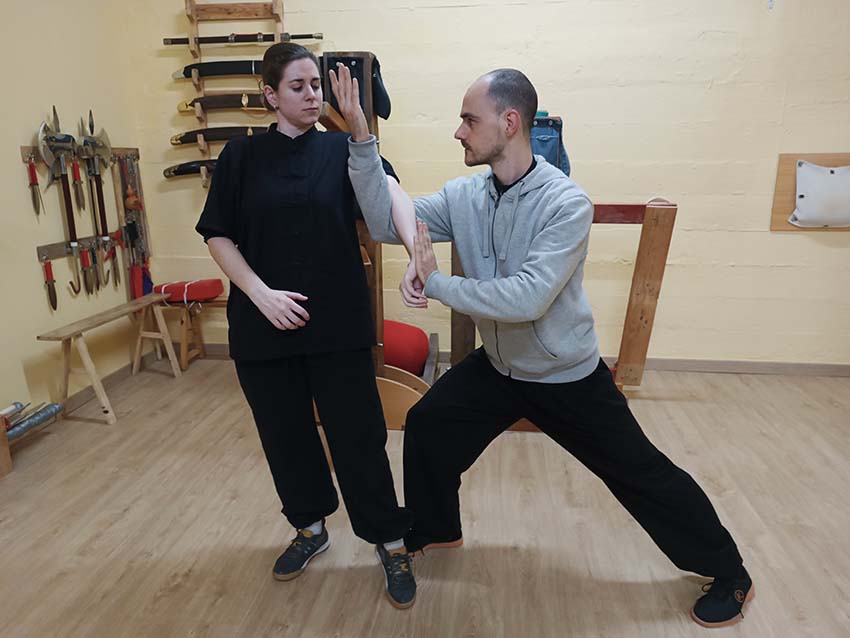
Ground fighting:
Like other styles of Kungfu, Choy Li Fut does not contain a ground fighting system, as it was not considered useful at the time when this martial art emerged in nineteenth-century China, due to the conditions and characteristics of the violence of the time. However, the knowledge of body mechanics that is acquired through the study of the system, especially through the area of kam-na, can undoubtedly be useful in the case of having to defend ourselves on the ground.
Drills:
In addition to a wide technical repertoire, Choy Li Fut is made up of a series of drills, both individual and in pairs, including conditioning and strengthening exercises, explosive power development exercises, sensitivity exercises, sparring exercises, etc.
In short, and although there are some characteristic exercises of the system, a good instructor must know how to create exercises for specific purposes when the need arises, since each apprentice is different and may require different methods.
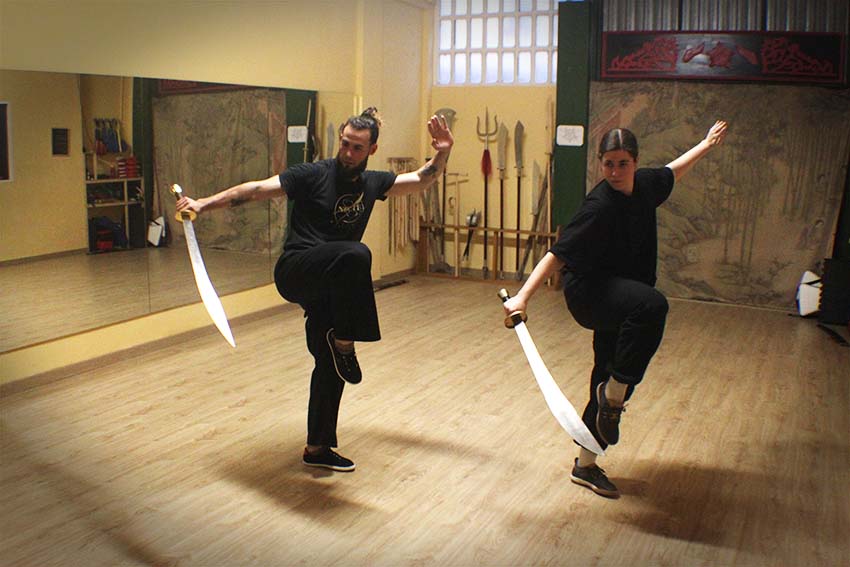
Forms:
Like all styles of Kungfu, Choy Li Fut contains a number of forms (standardized sequences of movements), including empty-hand and weapon forms, forms with training apparatus, and two-person forms of both empty hand and weapons.
In fact, the system contains more forms than virtually any other style, as each generation and each lineage has added new inventions.
Forms are a very useful tool in the transmission of the system, as they encode and sequence the extensive technical repertoire of Choy Li Fut. However, like any tool, they have their use and we must know how to use them properly.
In our opinion, the existence of so many forms in the system is a burden for many schools today, since in the "collecting" of forms – the memorization of a more or less long series of sequences as if they were an end in themselves – attention is lost on what really matters – that is, the internalization of the mechanics of movement that supposes the essence of the system—and the forms lose the purpose for which they were conceived.
For this reason, we believe it is important to reiterate that forms are useful, but they are neither essential, nor by themselves are they sufficient to convey the essence of style.
Weapons:
Once again, Choy Li Fut includes a wide range of traditional weapons in its repertoire. We can name a long list: sabre, staff, spear, rattan shield, fan, straight sword, halberds of different types, butterfly knives, bench, hoe, rake, double sabres, three/seven/nine section chain, carrying pole, three-section staff, hook swords, double daggers, cane or crutch, umbrella, etc.
As with forms, it can be understood, from the long list, that it is impossible to master them all. The claim to this dominance on the part of many present-day teachers is pretentious and only reveals their narrow-mindedness. How many masters of the past dedicated their lives to perfecting a single weapon, so as to pretend to master them all. The dispersion of training time across too wide a range of weapons means that it is impossible to truly delve deep into any of them. As a result, many masters specialize in one or two of them, although they may also have a basic knowledge of a variety of other weapons.
We believe that given the mechanics of the style, there are certain weapons that are more characteristic of it. These are: the sabre, butterfly knives, the staff and the spear. The staff and butterfly knives are, precisely, the first weapons that were taught to rural militias at the time of the emergence of the style.
Others, such as farming tools or weapons that derive from them (halberds), the bench and the fan, also marry well with the mechanics of this Kungfu system.
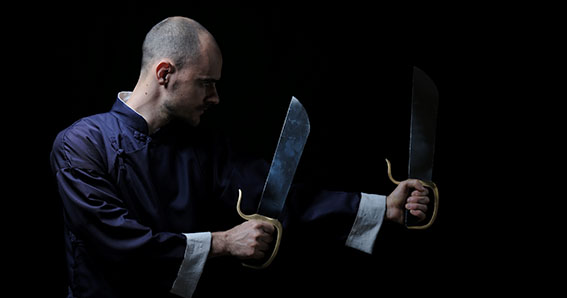
Training apparatus:
In addition to weapons, Choy Li Fut has a varied repertoire of training devices, such as wooden dummies, sandbags, plum blossom poles, etc.
The most characteristic of these is undoubtedly the wooden dummy (ching zong 稱椿), which is different from that used by other southern styles such as Hung Kyun or Wing Chun.
Choy Li Fut's wooden dummy is characterized by having, from bottom to top, a leg in the centre, two V-shaped arms at medium height, and a tilting arm at the top, from which it receives its name (ching zong: "tilting trunk"). This arm is operated by the practitioner by lowering it like a lever, and has a counterweight on the back that makes the arm come back up by itself.
The wooden dummy is also extremely useful, as it is a training partner with whom to practice when you do not have another person. Its usefulness lies, contrary to what many people believe, not in the ability to condition the body, but in fine-tuning the movements and our positioning with respect to the opponent, as well as certain techniques at close range.
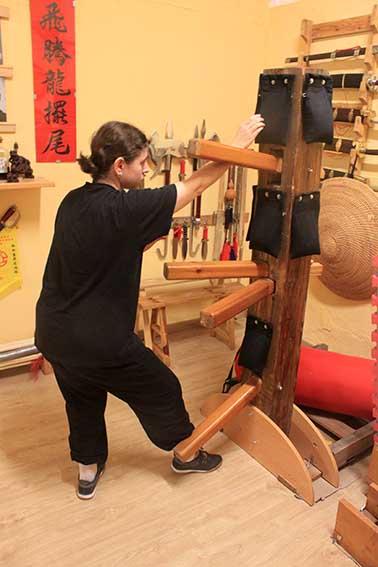
The ching zong 稱椿 or wooden dummy.
Philosophy:
The principles of Choy Li Fut are rooted in Buddhist and Taoist philosophy. Despite its usefulness in combat, it should only be used to protect one's own life, or that of those who depend on us.
The entire system is full of Buddhist references and Taoist concepts, such as the bat gwa 八卦, which refers to the eight states of change, and is used in the explanation and systematization of some movements, such as the footwork in eight directions. These concepts are important in understanding the style, but they are beyond the scope of this article.
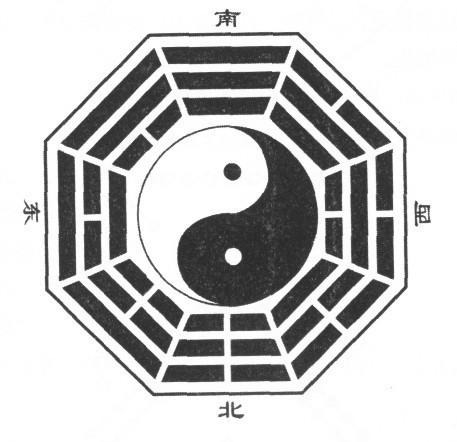
Eight trigrams (bat gwa 八卦).
Conclusion and usefulness nowadays
Choy Li Fut emerged at a time when peasants—the main martial arts practitioners at the time—had to defend their lives and property from looters and bandits. Therefore, its techniques are aggressive and potentially lethal.
This circumstance must be taken into account when properly understanding the system, since the reality of violence is changing and can be very different depending on the society in which each practitioner lives.
Despite the fact that Choy Li Fut is designed to defend one's own life, and that there may be more useful systems to reduce an opponent without hurting him – a necessity of the state security forces, and surely of anyone who does not want to end their days in prison for an altercation – we believe that it is still a very useful system for self-defense today, as long as the uses and applications of each technique are well understood. Only with a good understanding and self-control can we ensure the maximum effectiveness of the style without taking unnecessary risks.
In addition, training in this type of Kungfu can be a form of self-knowledge and internal strengthening—discipline, willpower, decision-making—that can lead us to a better relationship with our body and mind.
